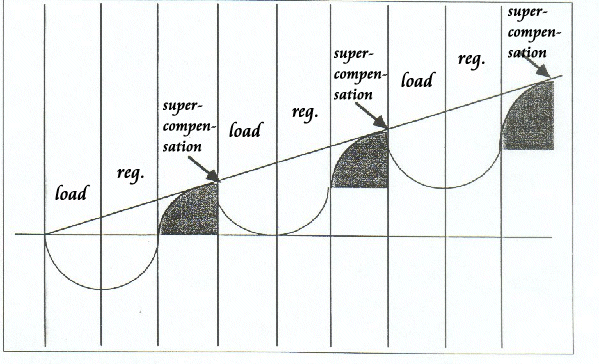In Part I I described the nature of cycles. In Part II I detailed why most endurance athletes utilize the Periodization model to get the competitive edge in racing. In this last segment I am going to describe to you the types of cycles most use and how it applies to the exercise/recovery balance.
Types of cycles in a triathlon season:
Macrocycle - entire season
Mesocycle - periods lasting 3-6 weeks each
Microcycle - weekly periods
Macrocycle
The first type of cycle is the macrocycle. The macro- prefix means “large” and that is exactly what it is. The macrocycle typically refers to an entire racing season. For most, this cycle will be about a year long, although in special cases it could be longer or shorter. Olympic athletes might have a macrocycle of 4 years as they train for optimal performance from one Olympiad to another.
In this example, I will draw the macrocycle as a 1 year season:

The green segment is your recovery period in the macrocycle, which is about 2-3 months for the typical training regimen. After many months of rigorous training and peaking for your big races, you need to give your body and mind a complete rest from the sport altogether, for a period of time (likely about 2 months) during the offseason. After their big race, I've seen a lot of people "burnt out" after months of training. They definitely need to shift gears to other pursuits for 2-3 months. Once the recovery is over, athletes like you should approach their next season (macrocycle) with renewed vigor and a completely healthy body.
Mesocycle
The next cycle is called the mesocycle. Each mesocycle varies from typically 4-8 weeks, depending on the training plan. Every macrocycle will contain a number of mesocycles. Each mesocycle has a distinct theme and intermediate goals. Mesocycles should fit nicely into your macrocycle. I now add the mesocycle to the sample above:

Again, there is a green section in each of the mesocycles. Again these are recovery periods that need to be built into these time periods, just as we did with the macrocycle. Notice how the 5th Mesocycle in the sample is all green compared to the others. This mesocycle falls completely under the macrocycle recovery period (the offseason). This means that every week in that Mesocycle is a recovery week.By placing easy recovery weeks properly with your heavy training weeks, you provide your body a partially sustained recovery in each mesocycle. This enables you to be “fired up” and healed enough to put the most of your energy into your harder weeks, thereby optimizing your training.
Microcycle
The last cycle that I will describe will be the microcycle. This is usually a week in length and is a day-by-day planning aid to get you to your immediate goals of your mesocycle and hopefully your long term goals defined by the macrocycle. Each mesocycle will contain a number of microcycles. In the sample chart, I will draw in 4 microcycles (weeks) into each mesocycle:

The resulting chart shows three hard weeks and an easier recovery week for each mesocycle.
Let's take a look at a sample microcycle:
And how does the training/recovery balance fit into this cycle? In day-to-day planning, you place 3-4 “key workouts” into your week and try to maximize them. Because a lot of effort is typically required of these “key workouts”, recovery is needed on certain days so that you are amply recovered for your next “key workout” in the week. For example, you pushed hard a 30 mile bike ride on Monday. The intensity of this workout warrants a necessary 24 hour recovery on Tuesday so that you are recovered and full of energy for that tough 10 mile run on Wednesday.
To put it all together, here is how a sample periodization plan looks like:
With these cycles in mind, next week's blog will put it all together by developing a sample training plan from the ground up.

